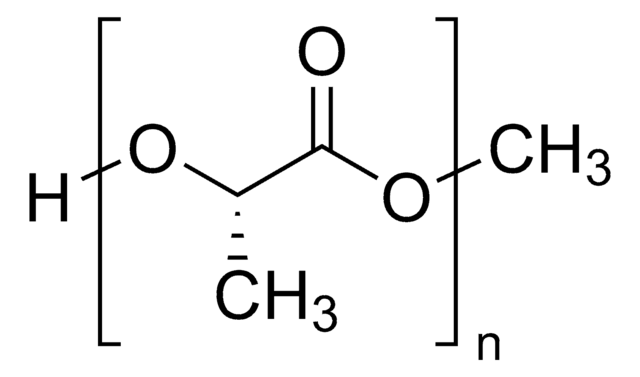67122
Poly(D-lactide)
inherent viscosity ~1.2 dl/g
Synonym(s):
D-Lactide polymer
Sign Into View Organizational & Contract Pricing
All Photos(1)
About This Item
CAS Number:
MDL number:
UNSPSC Code:
12352209
PubChem Substance ID:
NACRES:
NA.25
Recommended Products
Quality Level
mol wt
Mn ~90000
Mp ~95000
Mw ~124000
storage temp.
2-8°C
SMILES string
CC(O)C(O)=O
InChI key
JVTAAEKCZFNVCJ-UHFFFAOYSA-N
Application
Poly(D-lactide) (PDLA), a polymer of a stereospecific cyclic di-ester of lactic acid, is used in biomaterial research for the development of devices such as therapeutic drug delivery vessels. Poly(D-lactide) is used for the preparation of microparticles and resorbable polylactide scaffolds.
Storage Class Code
11 - Combustible Solids
WGK
WGK 3
Flash Point(F)
Not applicable
Flash Point(C)
Not applicable
Personal Protective Equipment
dust mask type N95 (US), Eyeshields, Gloves
Choose from one of the most recent versions:
Already Own This Product?
Find documentation for the products that you have recently purchased in the Document Library.
Customers Also Viewed
J R Sarasua et al.
Journal of materials science. Materials in medicine, 22(11), 2513-2523 (2011-08-23)
Bioresorbable polylactides are one of the most important materials for tissue engineering applications. In this work we have prepared scaffolds based on the two optically pure stereoisomers: poly(L: -lactide) (PLLA) and poly(D: -lactide) (PDLA). The crystalline structure and morphology were
Jingru Sun et al.
The journal of physical chemistry. B, 115(12), 2864-2869 (2011-03-10)
The effects of the addition of poly(D-lactide) (PDLA) on the crystallization behavior of poly(L-lactide)(PLLA) were investigated by means of differential scanning calorimetry (DSC) and temperature-dependent X-ray diffraction(XRD). When the blends were cooled from different temperatures (250, 240, and 190 °C)
Jun Shao et al.
The journal of physical chemistry. B, 116(33), 9983-9991 (2012-08-02)
Stereocomplex poly(lactide)s (sc-PLAs) were obtained from solution blending of 3-armed poly(L-lactide) (3PLLA) and linear poly(D-lactide) (PDLA) and between enantiomeric 3PLAs. Differential scanning calorimetry and wide-angle X-ray diffraction results indicated that racemic crystallites were preferentially produced in all the binary blends.
Jamal S Lewis et al.
Biomaterials, 33(29), 7221-7232 (2012-07-17)
Microparticulate systems for delivery of therapeutics to DCs for immunotherapy have gained attention recently. However, reports addressing the optimization of DC-targeting microparticle delivery systems are limited, particularly for cases where the goal is to deliver payload to DCs in a
Our team of scientists has experience in all areas of research including Life Science, Material Science, Chemical Synthesis, Chromatography, Analytical and many others.
Contact Technical Service







